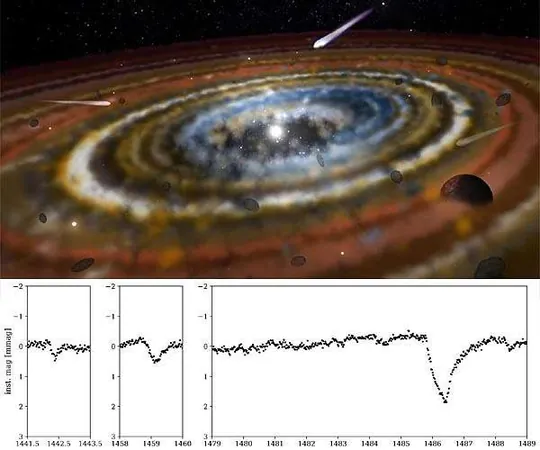
Astrophysicists Uncover the Mysterious Structure of Exocomet Belts Around 74 Nearby Stars - A Cosmic Revelation!
2025-01-19
Author: Wei Ling
Groundbreaking Development in Astrophysics
In a groundbreaking development for the field of astrophysics, researchers from Trinity College Dublin, alongside an international team of scientists, have made significant strides in unraveling the secrets of exocomets by successfully imaging the belts surrounding 74 nearby stars. This remarkable achievement opens up new avenues for understanding the formation and evolution of planetary systems, including our own Solar System.
The REASONS Study
The newly released study, dubbed REASONS (REsolved ALMA and SMA Observations of Nearby Stars), captures the light emitted from millimeter-sized pebbles within these cold exocomet belts. The exocomet belts, found at distances ranging from tens to hundreds of astronomical units (AU) from their host stars, maintain frigid temperatures that can plummet between -250 to -150 degrees Celsius. At such extremes, water and other compounds freeze solid, creating vital reservoirs necessary for planetary development.
Imaging Techniques and Observatories
This pioneering research represents the first comprehensive mapping of exocomet belts across a varied sample of star systems. The team utilized advanced imaging techniques from two of the most powerful radio telescopes: the Atacama Large Millimeter/submillimeter Array (ALMA) in Chile and the Submillimeter Array (SMA) in Hawaii. These observatories capture electromagnetic radiation at millimetric and submillimetric wavelengths, paving the way for unprecedented observations of exocomets and their structures.
Significance of Findings
Luca Matra, an Associate Professor at Trinity's School of Physics and senior author of the study, explains the significance of their findings: “Exocomets, composed of rock and ice and some as large as 1 kilometer, collide and break apart within these belts, leading to the formation of smaller pebbles we can detect. We’ve discovered that exocometary belts are present in at least 20% of planetary systems—including our very own.”
Diversity in Exocomet Belt Structures
Interestingly, the researchers noted a striking diversity in exocomet belt structures. While some resemble the narrow rings found in our Solar System’s Edgeworth-Kuiper belt, others appeared as wide disks. In fact, some systems displayed multiple eccentric rings or disks, hinting at the potential influence of unseen planets that may be shaping the dynamics of the belts through their gravitational forces.
Insights on Exocomet Populations Over Time
The expansive REASONS study not only highlights population-wide trends but also reveals compelling insights about how exocomet populations change with time. For instance, as planetary systems age, the presence of larger exocomets dwindles, causing a rapid decrease in the number of pebbles, particularly in belts closer to their host stars. Moreover, the study suggests that there may be hidden celestial bodies orbiting within these belts that are as large as 140 kilometers in diameter, possibly even Moon-sized!
Transformative Technology in Research
Dr. David Wilner, a Senior Astrophysicist at the Center for Astrophysics | Harvard and Smithsonian, emphasized the transformative power of the technologies employed in this research, stating, “ALMA and SMA are leading-edge tools that are revolutionizing our understanding of the universe. This collaborative effort behind the REASONS survey will leave a lasting legacy for future astronomical research.”
Future Prospects and Ongoing Research
As we look to the future, the dataset from the REASONS study holds immense promise. It not only charts the birth and evolution of these fascinating exocomet belts but also enables follow-up observations across various wavelengths, including from powerful instruments like the James Webb Space Telescope (JWST) and the upcoming generation of Extremely Large Telescopes. Researchers are eager to zoom further into the detailed landscapes of these cosmic domains, potentially unveiling even more secrets of our universe.
Conclusion
Stay tuned for more cosmic discoveries as we continue to explore the uncharted territories beyond our Solar System!


 Brasil (PT)
Brasil (PT)
 Canada (EN)
Canada (EN)
 Chile (ES)
Chile (ES)
 Česko (CS)
Česko (CS)
 대한민국 (KO)
대한민국 (KO)
 España (ES)
España (ES)
 France (FR)
France (FR)
 Hong Kong (EN)
Hong Kong (EN)
 Italia (IT)
Italia (IT)
 日本 (JA)
日本 (JA)
 Magyarország (HU)
Magyarország (HU)
 Norge (NO)
Norge (NO)
 Polska (PL)
Polska (PL)
 Schweiz (DE)
Schweiz (DE)
 Singapore (EN)
Singapore (EN)
 Sverige (SV)
Sverige (SV)
 Suomi (FI)
Suomi (FI)
 Türkiye (TR)
Türkiye (TR)
 الإمارات العربية المتحدة (AR)
الإمارات العربية المتحدة (AR)